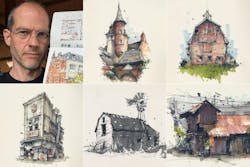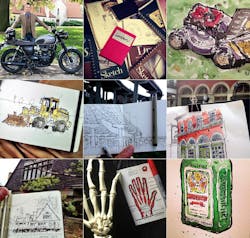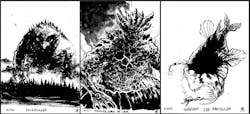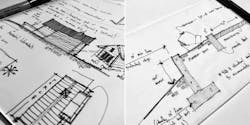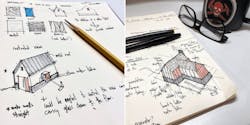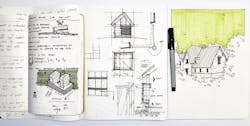Architects and Sketching
There is a nostalgia associated with sketching in the architecture profession. But is sketching still an integral part of the design process? Sharpen your pencils and pull out your favorite pen, because we are talking about "Architects and Sketching" in Episode 66 of the Life of an Architect podcast.
This is the first episode of the 2021 season here on Life of an Architect and I thought we would start off with a topic that is frequently on my mind and is heavily represented in the emails I receive almost daily: architects and sketching.
Sketching is hard for most people – it’s hard for me – and it’s okay if you end up using other tools to help get you to your destination. Architects’ have our own vocabulary, one full of jargon and lingo that I typically try to avoid, but we all understand what it means when you bring a pen and some paper together and start talking … something that I do literally all the time in my office.
While all of the sketches that will be used to populate today’s episode were created by me, none were created for me. There was someone else sitting on the other side of these sketches and we were discussing how something could/should be done and what that might mean in a larger context.
The original source of my sketching inspiration jump to 2:41
I didn’t plan on going into this on the recording but before I realized it, I was talking about a friend of mine from the early 90’s – Jon Kathol. I go on a bit and it’s a little embarrassing but I worked with Jon for only a single year, but it turns out that this was an important year for me in my development because I saw what Jon was doing with his design work and how he communicated his thought process graphically and I was completely envious of his abilities … but Jon being Jon took notice and spent some time giving me guidance and it was during this time that my sketches started to look like something other than embarrassing scribbles.
If you would like to encourage Jon to sketch more often, give him a follow on Instagram and tell him “Bob sent me …”. Jon Kathol on Instagram
Talent + Practice? jump to 5:55
I will admit that I spend some time on the app TikTok despite the fact that my 20’s are fairly distant behind me. While there are all sorts of videos of pre-teens dancing, there is actually a seemingly endless source of artists, fabricators, creators, etc. on there that I frequently find as a source of creative inspiration. There are so many talented people walking this planet and TikTok’s 1-minute format allows for not just a presentation of a final product, but a quick commentary from the artist themselves. In this case, it was from Norwegian artist Kim Holm discussing artistic talent during one of his “Daily Ink Monster” videos – a warm-up exercise he goes through before he begins his artistic day.
"Don’t wish for talent, practice is what will get you good … talent or no talent. Often talent is mistaken for simply having fun. If you can have fun doing a skill over and over again, then you will be able to do it until you get good. So, don’t wish for talent, try it out for a bit. If you find it fun, continue doing it. If you don’t find it fun, then maybe it’s not worth wishing for” – Kim Holm
I have long advocated that drawing is a skill and not a talent. Some people might have visualization gifts that are superior but someone who is willing to practice can develop the skills that will allow them to overcome their natural (or lack thereof) abilities.
Here is another perspective Kim takes on talent and practice (here).
Why don’t more designers sketch? jump to 8:07
As part of our conversation, we asked the very simple of question: “Why don’t more people sketch more as part of their design process?” As a professor, I asked Andrew if his students sketched at all and he said that it was an equivalent “No” and suggested that maybe it’s because it took too long. The idea that sketching as part of an iterative process slowing down the creative process is slightly baffling to me – maybe it’s because I’m old and sketching was how I learned to design? Andrew brought up @Housketcher on Instagram who sketches buildings constantly and wondered how long he takes to prepare one of his drawings … so I reached out to Albert Kiefer, the prolific professional visual designer working from Venlo, Netherlands about his work and how long he spends on average for each of these drawings. His response?
A whopping 45 minutes.
Clearly, speed comes with experience and practice.
4 “Secret” Tips that will improve your sketchesjump to 12:17
At first I wasn’t going to refer to these are secrets because I’m not entirely sure how “secret” they really are … however, it would seem based on the evidence at hand that most people don’t think about taking these very easy steps. In the podcast, Andrew and I discuss the value of these 4 sketching tips that will not add much time to your process and will ultimately elevate your sketch into a piece of communication that is easier for others to understand (and therefore appreciate and value).
• Draw Straight lines – for such a simple thing, drawing lines that are parallel to one another makes a huge difference. I would also like to add that just drawing straight lines will give your sketch more definition and confidence.
• Use Pen Weight – add profile lines, add a ground plane line … this is not rocket science but it will create a depth to your sketches that will literally transform them. In case you were wondering, I don’t sketch with two pens in real-time [gasp!!] I pretty much draw everything with one pen and then I go back over the appropriate areas with a heavier pen so the sole purpose of adding depth (which in turn improves legibility).
• Add hatching – this adds texture and scale to your drawing, not to mention visual interest. Things like crosshatching, stippling, wood patterns, glass marks
• Use color – any color is fine really but I will admit that proper color is new for me as I have typically just used various shades of grey to create tone, but even that was a successful step in the end product. Now I am actively trying to introduce color because I have aspirations to continually improve and I think this is a logical next step for me to explore and practice.
Three of the four sketches I used to illustrate my “tips” all came from my sketchbook and are for the same project – these are the same that we discussed in the show. They were actually created just within a few days of one another.
Why would you want to sketch? jump to 25:54
Andrew and I have both been in a position to hire architects for over the last 10-15 years and I am here to tell you that if you consider yourself a designer, particularly if you want to be a residential architect, you need to learn how to sketch in the moment and in front of other people (i.e. clients). I will concede that we have strong designers in my current office, many of whom do not sketch at all and even fewer that sketch in front of clients, but I think things are changing a bit with teleconferencing.
Before we could pin stuff up or have it up on a monitor and we could stand in front of it and point to things as we walked clients through our ideas … and ow that we are presenting digitally on teleconferencing calls, you can’t do that. We find that the people who can sketch using a digital pen using their mouse on the screen are far more effective at communicating than those who can not.
For my residential projects, the vast majority of them include sitting at a dining room or kitchen table, reviewing drawings, and working through possible modifications using a pen and a roll of trace paper. We solve problems collaboratively and in that moment, and as a result, those meetings are far more productive than if we respond with “let me get back to you on that one …”
Want to get better? jump to 40:35
I suppose we should talk about sketchbooks if we are going to spend any time talking about sketching but I thought I would list 3 things as an encouragement to prime your sketching pump.
• Carry a sketchbook. Go get a cheap one, one that you won’t care if you lay an egg in it (This is the one I mentioned that fits in your back pocket: Moleskine Cahier Journal, soft cover 5″ x 8.5″ just make sure you pick the sort of paper you want from the choices, dotted, plain, ruled, or squared)
• Give it a go every day. Being bad at it is better than not doing it at all.
I truly believe the trajectory of your career will be altered if you can sketch so in the simplest of terms, what have you got to lose?
We are introducing a new version of the hypothetical question here on Life of an Architect. Technically we’ve already been doing some version of this and calling it a hypothetical question but we are going to make it a bit more legitimate.
Would you rather? jump to 45:10
In an effort to open up our possibilities, as well as shorten our responses, we are going to substitute in the occasional “Would you rather?” question since they are at their core, an option between two choices. This is the first of such questions we are presenting for the 2021 podcast season … it’s particularly ridiculous.
"Would you rather the aliens that make first contact on earth be robotic or organic?"
There are only two answers to this question, either Organic or Robotic … but can someone still get the answer incorrect? Of course.
Looking back over 25 years of my sketches is kinda freaky to be honest. I’m not sure I would have made this observation had I not started writing this blog and posting my sketches for others to view. While I don’t think I am particularly gifted at sketching beautiful drawings, I do think that I have a style that has become recognizable as my own – and that is pretty awesome to discover. Over the last four years, I have published a handful of articles where I share my thoughts and observations on the process and value that I believe sketching offers an architect.
Through these posts, I get a considerable amount of feedback from people who are kind enough to let me know that they like the way I sketch. I’ve even mailed off a few sketches to people who have requested them – a mind-boggling idea quite honestly – because the people in my office who get my sketches all the time are more than happy to toss them recycle bin 100% of the time.
If you want some more practical real-world tips, I wrote Architectural Sketching [or How to Sketch like Bob Borson] back in 2014, and there are a few additional simple techniques you can employ to help you with your sketching.
I hope this post inspires you to pull out your pens and paper and start sketching. I’ve come to believe that if you can sketch well enough to convey your ideas, our clients are the real winners.
Happy sketching!
